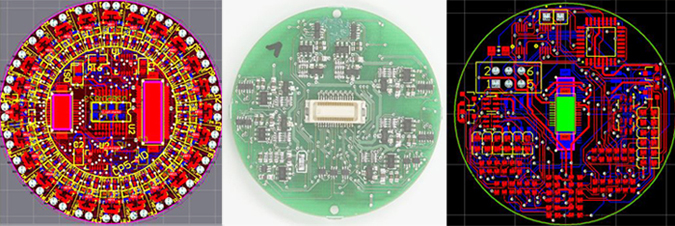
Claytronics Hardware
Through hardware engineering projects, researchers in the Carnegie Mellon-Intel Claytronics Project investigate the effects of scale on micro-electro-mechanical systems and model concepts for manufacturable, nanoscale modular robots capable of self-assembly.
Catoms created from this research to populate claytronic ensembles will be less than a millimeter in size, and the challenge in designing and manufacturing them draws the CMU-Intel Research team into a scale of engineering where have never been built. The team of research scientists, engineers, technicians and students who design these devices are testing concepts that cross the frontiers of computer science, modular robotics and systems nanotechnology.
The team of research scientists, engineers, technicians and graduate and undergraduate students assembled at Carnegie Mellon and in the Pittsburgh Intel Lab to design these devices is testing the performance of concepts beyond boundaries commonly believed to prevent the engineering of such a small scale, self-actuating module that combines in huge numbers to create cooperative patterns of work.
At the current stage of design, claytronics hardware operates from macroscale designs with devices that are much larger than the tiny modular robots that set the goals of this engineering research. Such devices are designed to test concepts for sub-millimeter scale modules and to elucidate crucial effects of the physical and electrical forces that affect nanoscale robots.
- Planar catoms test the concept of motion without moving parts and the design of force effectors that create cooperative motion within ensembles of modular robots.
- Electrostatic latches model a new system of binding and releasing the connection between modular robots, a connection that creates motion and transfers power and data while employing a small factor of a powerful force.
- Stochastic Catoms integrate random motion with global objectives communicated in simple computer language to form predetermined patterns, using a natural force to actuate a simple device, one that cooperates with other small helium catoms to fulfill a set of unique instructions.
- Giant Helium Catoms provide a larger-than-life, lighter-than-air platform to explore the relation of forces when electrostatics has a greater effect than gravity on a robotic device, an effect simulated with a modular robot designed for self-construction of macro-scale structures.
- Cubes employ electrostatic latches to demonstrate the functionality of a device that could be used in a system of lattice-style self-assembly at both the macro and nano-scale.
Each section devoted to an individual hardware project provides an overview of the basic functionality of the device and its relationship to the study of claytronics. In addition, each project page is paired with a page of design notes that offer more detail on the steps in building the device.
As these creative systems have evolved in the Carnegie Mellon-Intel Claytronics Hardware Lab, they have prepared the path for development of a millimeter scale module that will represent the creation of a self-actuating catom - a device that can compute, move, and communicate - at the nano-scale.
With the millimeter scale modular robot, the Claytronics Hardware Lab will demonstrate the feasibility of manufacturing catoms in the quantities needed to produce dynamic 3-dimensional representations of original objects.

